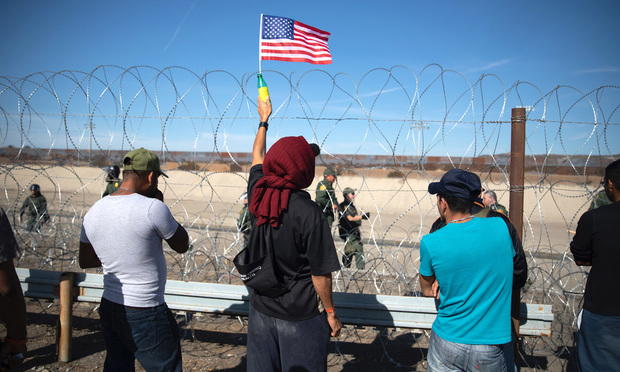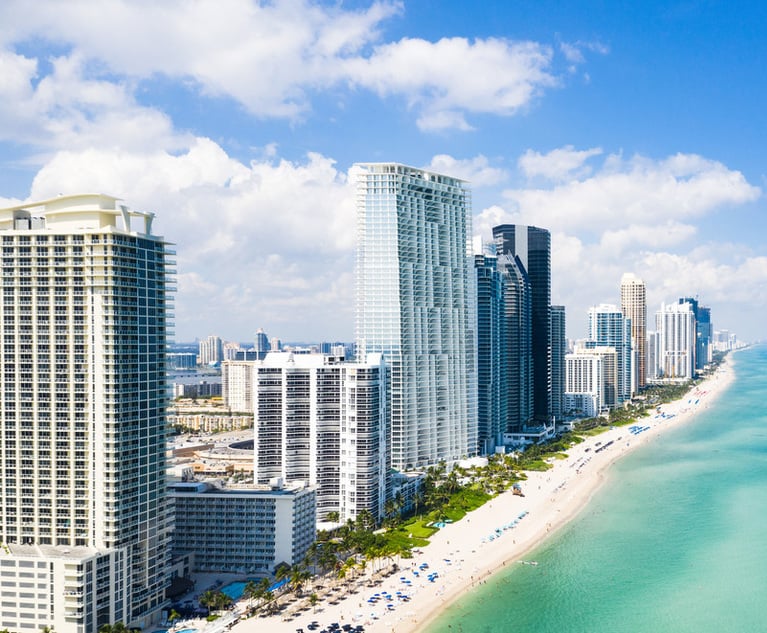Guidelines Ask Agents to Target Spanish Speakers at Border
The Trump administration launched the program in late January in what marks a potentially seismic shift on how the U.S. handles the cases of immigrants seeking asylum and fleeing persecution in their homeland.
March 07, 2019 at 10:35 AM
5 minute read
 A Central American migrant holds an American flag in front of barbed wire along the U.S. and Mexico border in Tijuana, Mexico, on Nov. 25, 2018. Photographer: Tomas Ayuso/Bloomberg
A Central American migrant holds an American flag in front of barbed wire along the U.S. and Mexico border in Tijuana, Mexico, on Nov. 25, 2018. Photographer: Tomas Ayuso/Bloomberg
Border agents have been told to explicitly target Spanish speakers and migrants from Latin America in carrying out a Trump administration program requiring asylum seekers to wait in Mexico, according to memos obtained by The Associated Press that reveal some inner workings of a top government priority to address the burgeoning number of Central Americans arriving in the country.
The Trump administration launched the program in late January in what marks a potentially seismic shift on how the U.S. handles the cases of immigrants seeking asylum and fleeing persecution in their homeland. The program initially applied only to those who turned themselves in at official border crossings, but a memo from a division chief of the Border Patrol's San Diego sector says it expanded Friday to include people who cross the border illegally.
The guidance includes instruction about various groups of immigrants who are not to be sent back to Mexico and instead go through the traditional asylum process in the U.S. immigration court system. They include pregnant women, LGBT migrants and people suffering medical issues. Authorities said previously that Mexican asylum seekers are excluded, as are children traveling alone.
U.S. officials must check if the asylum seeker has any felony convictions and notify Mexico at least 12 hours before they are returned. Those who cross illegally must have come as single adults, though the administration is in talks with the Mexican government to include families.
The program is being implemented as border arrests soared in February to a 12-year-high and more than half of those stopped arrived as families, many of them asylum seekers who generally turn themselves in instead of trying to elude capture. Guatemala and Honduras have replaced Mexico as the top countries, a remarkable shift from only a few years ago.
The instructions say Mexican officials insist that no more than 20 asylum seekers are returned each day from San Diego to Tijuana, Mexico, on Monday through Saturday, underscoring challenges that the U.S. faces in trying to quickly ramp up one of its top border enforcement priorities and most significant changes to the U.S. immigration system of Donald Trump's presidency. Authorities said Tuesday that more than 76,000 were stopped or apprehended at the Mexican border in February, more than double the same period last year.
A memo on Tuesday to top Border Patrol officials in San Diego said the agency is under “pressures to utilize this program as much as we can.”
Asylum-seeking families are typically released from U.S. custody immediately and allowed to settle with family or friends while their cases wind through immigration courts, which often takes years. Critics say that amounts to “catch-and-release,” which administration officials want to limit with the new Mexico program.
In a statement, the Department of Homeland Security described the program as “another tool available in the law” to respond to the record numbers of Central American migrants arriving at the border in recent months. The agency said the program is being carried out in a “thoughtful and deliberate manner” that protects vulnerable migrants and is done in collaboration with the Mexican government.
Two U.S. officials who were not authorized to discuss the internal guidance and spoke on condition of anonymity confirmed contents of the memos obtained by the AP.
Explicitly targeting Spanish speakers and Latin Americans had not been previously disclosed, though some critics said it was no surprise considering that recent arrest numbers are largely Central Americans.
Judy Rabinovitz, an attorney for the American Civil Liberties Union, said the criteria “does smack of the same concerns we had in the Muslim ban,” referring to Trump's ban on travelers from several predominantly Muslim countries, which was eventually upheld by the Supreme Court.
“We know they are trying to get at Central American asylum seekers but to see it written there so blatantly is so disturbing,” said Rabinovitz, whose organization was among those that sued the administration last month to block the policy.
Secretary Kirstjen Nielsen has made the administration's “Migrant Protection Protocols” a top priority, working for months with Mexican counterparts to seal the broad outlines of an agreement in November.
Testifying Wednesday in Congress, Nielsen said the U.S., working with Mexico, was exercising its authority to make people wait outside the country.
“All asylum seekers have the opportunity to present their case,” she said. “We're not turning anybody around.”
The effort has gotten off to a modest start amid mixed signals from Mexican officials and been limited to San Diego. Tonatiuh Guillen, who heads Mexico's immigration agency, told the AP that Mexico accepted 112 Central Americans during the first five weeks, including 25 children. Homeland Security has declined to release numbers.
A Homeland Security official, speaking to reporters Friday on a conference call on condition of anonymity, said the administration planned to grow the effort exponentially across the border, including to people who cross illegally between border crossings. The official declined to say when or where but said it was likely to be expanded in the next few weeks.
One memo obtained by the AP shows that it had been expanded on the same day.
Elliot Spagat reports for the Associated Press. Associated Press writer Colleen Long contributed to this report from Washington.
This content has been archived. It is available through our partners, LexisNexis® and Bloomberg Law.
To view this content, please continue to their sites.
Not a Lexis Subscriber?
Subscribe Now
Not a Bloomberg Law Subscriber?
Subscribe Now
NOT FOR REPRINT
© 2025 ALM Global, LLC, All Rights Reserved. Request academic re-use from www.copyright.com. All other uses, submit a request to [email protected]. For more information visit Asset & Logo Licensing.
You Might Like
View All
Winston & Strawn Snags Sidley Austin Cross-Border Transactions Partner in Miami
2 minute read
Miami’s Arbitration Week Aims To Cement City’s Status as Dispute Destination
3 minute read
Brazil Is Quickly Becoming a Vital LatAm Market for Greenberg Traurig, Other US Law Firms
5 minute readTrending Stories
Who Got The Work
J. Brugh Lower of Gibbons has entered an appearance for industrial equipment supplier Devco Corporation in a pending trademark infringement lawsuit. The suit, accusing the defendant of selling knock-off Graco products, was filed Dec. 18 in New Jersey District Court by Rivkin Radler on behalf of Graco Inc. and Graco Minnesota. The case, assigned to U.S. District Judge Zahid N. Quraishi, is 3:24-cv-11294, Graco Inc. et al v. Devco Corporation.
Who Got The Work
Rebecca Maller-Stein and Kent A. Yalowitz of Arnold & Porter Kaye Scholer have entered their appearances for Hanaco Venture Capital and its executives, Lior Prosor and David Frankel, in a pending securities lawsuit. The action, filed on Dec. 24 in New York Southern District Court by Zell, Aron & Co. on behalf of Goldeneye Advisors, accuses the defendants of negligently and fraudulently managing the plaintiff's $1 million investment. The case, assigned to U.S. District Judge Vernon S. Broderick, is 1:24-cv-09918, Goldeneye Advisors, LLC v. Hanaco Venture Capital, Ltd. et al.
Who Got The Work
Attorneys from A&O Shearman has stepped in as defense counsel for Toronto-Dominion Bank and other defendants in a pending securities class action. The suit, filed Dec. 11 in New York Southern District Court by Bleichmar Fonti & Auld, accuses the defendants of concealing the bank's 'pervasive' deficiencies in regards to its compliance with the Bank Secrecy Act and the quality of its anti-money laundering controls. The case, assigned to U.S. District Judge Arun Subramanian, is 1:24-cv-09445, Gonzalez v. The Toronto-Dominion Bank et al.
Who Got The Work
Crown Castle International, a Pennsylvania company providing shared communications infrastructure, has turned to Luke D. Wolf of Gordon Rees Scully Mansukhani to fend off a pending breach-of-contract lawsuit. The court action, filed Nov. 25 in Michigan Eastern District Court by Hooper Hathaway PC on behalf of The Town Residences LLC, accuses Crown Castle of failing to transfer approximately $30,000 in utility payments from T-Mobile in breach of a roof-top lease and assignment agreement. The case, assigned to U.S. District Judge Susan K. Declercq, is 2:24-cv-13131, The Town Residences LLC v. T-Mobile US, Inc. et al.
Who Got The Work
Wilfred P. Coronato and Daniel M. Schwartz of McCarter & English have stepped in as defense counsel to Electrolux Home Products Inc. in a pending product liability lawsuit. The court action, filed Nov. 26 in New York Eastern District Court by Poulos Lopiccolo PC and Nagel Rice LLP on behalf of David Stern, alleges that the defendant's refrigerators’ drawers and shelving repeatedly break and fall apart within months after purchase. The case, assigned to U.S. District Judge Joan M. Azrack, is 2:24-cv-08204, Stern v. Electrolux Home Products, Inc.
Featured Firms
Law Offices of Gary Martin Hays & Associates, P.C.
(470) 294-1674
Law Offices of Mark E. Salomone
(857) 444-6468
Smith & Hassler
(713) 739-1250







